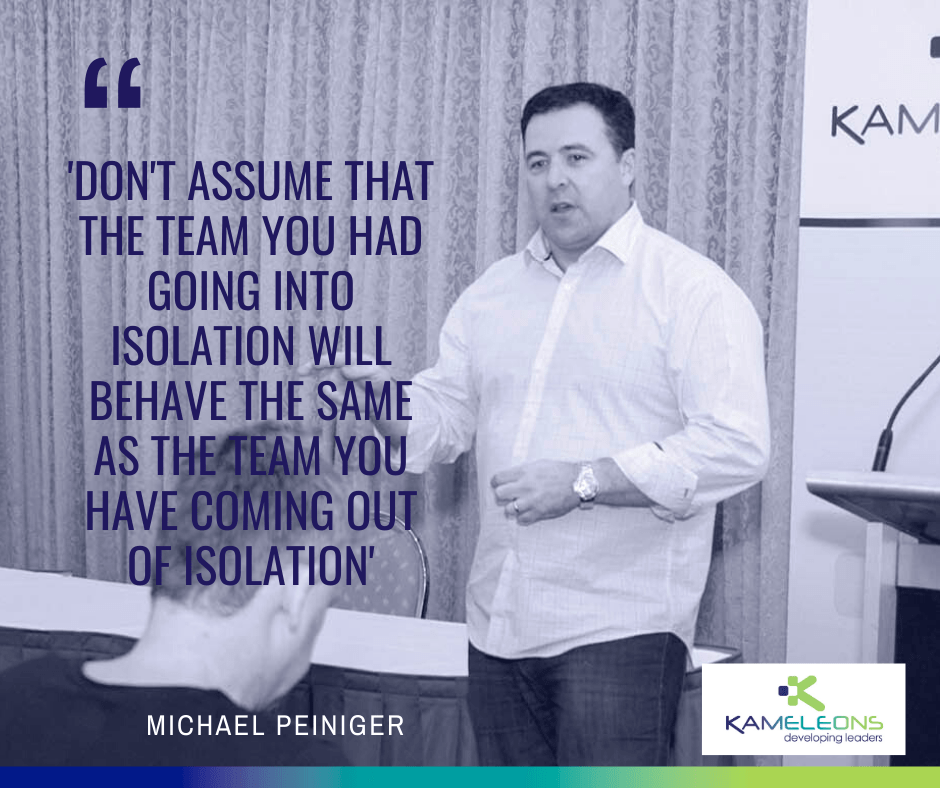When it comes to leading yourself effectively, it is all about quality over quantity.Have you had a realisation like this in the last couple of weeks? This was a timely reminder in a post from Peter Horrocks. There have been so many changes to routines and patterns – and while plenty have impacts and hardships on many – some changes to the routine have been for the better.
For me, the lower graphic could have broken hard work into even smaller segments -many of which I have been reminded of or relearned in the last couple of weeks as.
Productive hard work includes (and can include combinations of):
1️⃣ Focussed time away from social media
2️⃣ Time to plan and work out priorities
3️⃣ Opportunity to think deeper on one topic at a time
4️⃣ Discussion with peers to problem solve and look at an issue from all sides
5️⃣ Time to reflect on that works and what doesn’t
6️⃣ ‘Head down, bum up’ completion of tasks while avoiding procratination
7️⃣ Time to actually celebrate and be happy with what was completed
What a difference these things have made to not only completing larger tasks (that honestly were being avoided), but being satisfied in the results. What changes to your routine have been for the better int he last couple of weeks – that you will keep moving forward?
#leadership #leadershipdevelopment #executivecoaching #leaders #coaching#highperformanceteams
Team Behaviour Out of Isolation – Your Response as a Leader
Your response as a leader will have a huge influence on your team behaviour in the next few weeks. Your team will have changed dramatically in the last 8 weeks – beyond schooling arrangements and the comfort / discomfort of working from home or the hours worked. Don’t assume that the team you had going into isolation will behave the same as the team coming out of isolation. Your team members may have a very different relationship with:
?You – as both leader, mentor, peer or friend
?The business – is the trust still there
?Security (both physical and financial)
?Challenge – they are looking from work
?Autonomy – and micromanagement
?How important work is to them overall
?The support they are looking from the team
?The future they see at your business
There is no need to be afraid of having this conversation with your team – I am sure your relationship as a leader / manager has also changed in relation to a number of the dot points.As a leader, we deal with who we have and the situation in front of us NOW, not what it was. Take the opportunity to bring yourself up to date with your team’s expectations.
#leadership #leadershipdevelopment #leadershipcoach #leader #executivecoaching #coaching #highperformanceteams #developingleaders
Leadership Program Testimonial – Loryn Chaplin
A huge thank you to Loryn Chaplin for recent testimonial following our recent Leadership Program! Wednesday is all about gratitude at IMLD – it is a pleasure to work with dedicated leaders that want to extend knowledge and skills for themselves as well as their teams! To be able to have open, honest and constructive conversations in the workplace is crucial at all times, but especially now with circumstances that can change rapidly. Thank you
#leadership #leadershipdevelopment #leader #highperformanceteams #executivecoaching #coaching #developingleaders #leadershipcoach
Cultural Silos – 4 Reasons For Them and 6 Ways Leaders Can Break Them Down
When it comes to leading managing the dynamics of the people in your team and breaking down cultural silos, near enough is not good enough. When people talk about a business being ‘siloed’ – what they are actually referring to is a business that has created so many people ‘work arounds’ or people ‘avoidances’, that entire business units no longer function effectively. This can stem from something as simple as two Department Heads not liking each other and deciding not to talk. Little ‘work arounds and avoidances – not debating a point you disagree with, avoiding a team member, following an outdated process – all start to add up over time. These people inefficiencies cost businesses millions of dollars in wasted time, effort and frustration, but they are hardly talked about.
Cultural Silos are Created By Leaders
There are 6 simple ways in which cultural silo’s are created by Leaders:
1. People Processes Treated Differently To Business Processes
If a business process is inefficient, businesses utilise principles such as six-sigma or lean to ensure that it is rectified. If the finances of the business are inefficient, a formal review may take place to ensure money isn’t wasted. If safety processes are inadequate, a 5-S process may take place. People inefficiency is treated differently – it is often ignored, done badly, worked around.
2. People Process Ignored Cultural Silos
People behaviours that impact performance can be ignored for many reasons:
- It seems too easy. ‘This is just common sense’ is a phrase that ignores the simple fact that miscommunication can cause people issues and inefficiency. What is common sense to one person is very different to another – there is no ‘common’ sense. We all have different experiences, emotions, behaviour patterns, preferences and work styles – to assume that something is common sense is really a little naive.
- Challenging entrenched behaviours can be hard. Very few people actually like conflict – that uncomfortable feeling in your gut when you challenge a behaviour or hold someone to account for something that hasn’t been completed. Instead of feeling uncomfortable in the moment, it can be easier to ignore the problem until it comes up again.
3. People Process ‘Worked Around’
- It isn’t as important as the bigger things. One of the reasons that a people process is not dealt with is a simple justification – ‘it isn’t important’ or ‘it isn’t as important as xxx’. This often masks a personal discomfort with having a difficult or uncomfortable conversation. People issues and misunderstandings can have a significant impact on performance – choosing to work around them because they seem less important than other things just creates a bigger problem in the future.
- Collusion. Many people behaviour are ignored for a very simple reason – the leader / manager may have done the same thing themselves. Rather than discussing the problem, they avoid it for fear of what might be said back to them – ‘but, you do that as well’. It results in behaviour collusion – I won’t mention your behaviour if you don’t mention mine – a pattern that can spiral a teams performance.
4. People Process Done Badly
- It gets Personal. Often when Managers and Leaders seek to address a people problem, they make a fundamental error. Knowingly, unwittingly or accidentally, they attribute a problem behaviour is attributed to a ‘problem person’. It gets personal. The focus becomes the person (and the implicit judgement of the person that comes with it) rather than the correction or adjustment of the behaviour that caused the issue int he first place. A minor correction in behaviour then becomes a major problem between people – in football parlance, it would be called ‘playing the person, not the man/woman’.
- It Gets Judgemental. When people issues are raised poorly, people can feel criticised or judged, and their behaviour often fits a familiar pattern – fight (argue, talk back or get angry), flight (don’t listen, avoid or leave) or stand still (hear the words, but are so threatened or surprised by the information, they don’t respond). Responses can be delayed, shared with other people after the fact, or not discussed again bu the people that need to. After a poor interaction, there is a tendency to judge the other person – ‘A always says this’, or ‘B never does the following’ – resulting in a people problem that two people will not attempt to solve.
How Do Leaders Break Down Cultural Silos?
Breaking down solids on a business requires persistent and clear behaviour from all staff, particularly those in senior positions. As mentioned in a recent Forbes article, these behaviours can have large negative consequences. Some of things that can be done to address silo behaviour include:
- Be clear on what you want. Being clear on the behaviour that you want people to demonstrate, as well as clear on the behaviour that is inappropriate. Think on the things that you love your team to do, and well as what you don’t – then tell them.
- Don’t walk past small misunderstandings. Small misunderstandings turn into big misunderstandings and judgements over time – take to time to talk clearly with people if there has been a disagreement or misunderstanding and clarify it quickly.
- Play the Ball, Not the Person. When raising an issue, focus on the behaviour that you want to discuss and how you want it changed, rather than focussing on the person. The person doesn’t need correcting or changing – only the behaviour.
- Avoid ‘Absolute’ Judgements. If someone has made a mistake or done something wrong in the past – it does not mean they should be judged for it forever. Discuss a behaviour, let the person correct it, and move on. If they do the same behaviour again, mention it and correct it again – and be clear why you are doing it.
- Acknowledge Your Errors. There are times when you have to discuss a siloed behaviour that you have done yourself. Acknowledge your behaviour and correct it anyway – and don’t be a hypocrite. Just because you have done something before doesn’t mean that you need to do it again, and neither does the person you are correcting.
- Seek to Understand. Silo’s are not created by bad people – they are most often created by passionate, driven people trying to look after their people. Take the time to understand what the other person / team wants and needs and don’t judge focus on your own needs – you will be far less likely to create a misunderstanding.
Silo’s can be broken down when leaders and managers take the time to not walk past the little things and make relationships between people an important part of business success.
Related IMLD Articles:
a. Negative Culture = Negative Leadership
b. The 5 Things Supervisors want from their senior managers
c. 5 Leadership Development Lessons Business can learn from the military
Leadership Development: 10 Negative Things to Give Up
When it comes to your leadership development, there are things to do as well as some things to give up. This fantastic graphic was recently posted on Zig Ziglar’s Facebook page (credit to the author). The list reminded me of many of the Coaching Outcomes that my Executive Coaching clients are seeking to impact in the leadership, with their team and in their lives.
While each of the ’10 Things to Give Up’ could fall into the realm of personal development, the impact of these behaviours on leadership, team and culture is profound.
- Excuses. Excuses for any form of behaviour prevent us from taking ownership, being responsible and moving forward with action. Maintaining an excuse for a poor performance or mistake creates a lack of trust from the people around you, and creates a mindset that makes the behaviour more likely to happen again.
- Self Doubt. This could be the lead title to several of the other items in the list. With leaders, this can be seen with excessive use of meetings and group discussions to arrive at decisions, an overwhelming desire to create consensus within a group, and endless looking back over ‘what if’. Self doubt can not only result in lost opportunities, but increased questions and scrutiny from (an often well-meaning) team, reinforcing self-doubt.
- Fear of Failure. One of the behaviours listed that can fall into a ‘pattern’. Fear of failure sounds like it could be a driving force, encouraging a leader to do more, be more, achieve more. When focussed on moving forward, the behaviours can be positive. Fear of failure is more sinister than that, crippling a leaders drive, fearing a misstep or a mistake will impact their credibility, integrity, leadership or legacy. The huge concern about impacting one of those values can prevent a leader from taking action when needed.
- Procrastination. In my opinion, this is one of the most pervasive and wide-spread of the behaviours to give up. Not wanting to start a task, avoiding the important tasks, wasting time on little things rather than higher priorities – while not often spoken of, this behaviour is widespread and corrosive. Not having clear routines, not creating a To-Do List, avoiding a To-Do list and not prioritising your work are key behaviours of procrastination.
- People Pleasing. We all know someone (and I am sure many of us have been someone) who doesn’t know how to say ‘No’. But this behaviour can be more than a lack of assertiveness and willingness to please others. An over-inflated sense of responsibility, need for everything to be perfect and a desire to maintain team harmony can all drive this exhausting behaviour.
- Fear of Success. Many leaders don’t understand this fear – ‘Why would I not want to be successful?’. The opposite side of the same coin is the pattern behaviour, fear of failure. If someone’s ‘pattern’ or thoughts they consistently tell themselves (because of history, experience etc) is that they don’t deserve success or have never had success, then when it comes it is going to feel unnatural and out of place. While logically it doesn’t make sense (even to the people that have this fear), leaders can create behaviours that inhibit success to feel more comfortable ie. You could win a work proposal worth $$$ if you submit it – but you wait and delay submission past the due date. If failure is a pattern you are used to, this kind of behaviour can seek to maintain the pattern.
- Negative Thinking. When the negative thoughts outweigh the positive, it can lead to the Other Things To Give Up, such as the fears of success and failure and self-doubt. Negative thinking refuses to see the positive alternative to a decision and highlights the down side. When teams expect leaders to problem solve, be creative and show the way, negative thinking can stifle even the most driven and positive followers.
- Negative Self-Talk. This is that ‘little devil’ voice that whispers negative thoughts into you ear – do you have one of those? This is negative thinking on repeat, focussed on what you personally can’t achieve. The mind of a leader is a powerful thing, and negative thinking can be reinforced through negative emotions and behaviours. A vicious spiral.
- Judgement of Yourself and Others. Judging yourself harshly can lead to shame – a negative spiral where you ‘beat yourself up’ for things that have gone wrong or didn’t go your way. Rather than take action to improve and change, shame assumes that chastising yourself is action. Judging others can lead to a lack of tolerance and understanding of intentions and behaviours – the grace that we can often give ourselves when we have made a mistake.
- Negative people in your circle. It is incredibly hard to stay positive and motivated when you are surrounded by negative people. Have enough negative people in your team or business, and you have a negative culture that can be hard to shake.
Which of the ’10 Things to Give Up’ do you need to give up? What impact would it have on you, your leadership, your team, your business, your culture and your bottom line?
If one or more of the 10 Things To Give Up is impacting you and your leadership, get in touch with us via email or phone to discuss how we can work with you to work through them, create strategies, processes and routines to avoid them and surround yourself with people that will help you through them.
Effective Leadership Coach – 7 Key Questions To Ask
When choosing an effective leadership coach, you want to ensure that you are going to get results. In an unregulated industry, it is very easy to get caught up in the hype of a savvy sales pitch or a professional looking website. But there are some simple questions to ask that can differentiate the good from the average, the true partner in developing your skills as a leader as opposed to an expensive waste of time and effort.
During my first meeting or call with a potential client, I have found that most leaders don’t know what to ask to determine if I am the ‘right fit’ for them. Often they are looking for someone who they feel comfortable with and have the right chemistry. While that is certainly important, there are many other things you can ask to get the right leadership coach for you. Here are 8 key questions you can ask a potential coach to determine if they are effective and more importantly, the right coach for you.
1. What is Your Experience as a Leader?
This might seem obvious, but many consultants calling themselves leadership coaches have actually never lead people in a team. For all of the learning and reading a person has done, nothing can substitute having experience in a leadership role – making decisions, counselling / coaching and performance managing team members, holding other accountable for results, setting a clear vision – all of the things that you have to do as a leader.
Ask:
- ‘What experience have you had leading a team?’
- ‘What industries have you worked in and for how long?’
- ‘What was you toughest experience as a leader managing people?’
2. What is Your Own Coaching Style?
Many leadership coaches follow a formula, a step-by-step guide to coaching that they have learned through an institute, school or other coach. Having a system or a process is important – but you don’t want to work with someone who can’t adjust their format / process / style to meet your immediate needs. If you want to work on a pressing issue that impacts you right now, you shouldn’t have to wait for Lesson 17 in Week 10 to learn and discuss how to deal with it.
In addition, have they developed their own lessons from experience? An effective coach has learnt from what they were taught, adapted from their experience and developed their own material. Would you rather work with a leadership coach that can adapt to your needs and discuss an appropriate lesson from personal experience, or someone that needs to refer and check with the book?
Ask:
- ‘What models do you use to aid your coaching?’
- ‘Can you outline the type of lessons / learning we can cover?’
- ‘Have you written your own models / lessons from experience?’
Listen to how they discuss their work and consider the following questions for yourself:
- ‘Does this sound like it will aid in my development as a leader?’
- ‘Will this person’s style compliment my own’
3. Who Else Would You Recommend?
Deciding on an effective leadership coach is a personal preference – you have to feel comfortable that the person will work with you, guide you, encourage you as well as challenge you. If you decide that the persons style doesn’t suit you, can they / will they recommend a leadership coach more suitable? An effective leadership coach knows that they don’t appeal to everyones style and that fit is important. An effective coach in the industry will personally know several other effective leadership coaches of different styles that they can refer you to. Anyone that can’t is looking more for the sale and less for your welfare and development.
Ask:
- ‘If you aren’t my best fit as a coach, who else would you recommend and why?’
4. What Recommendations and Success Stories Do You Have?
This question seeks to get past the fancy website and the sales pitch. An effective leadership coach will have dozens of recommendations from previous clients that are happy with the work that was completed, and even happier to tell others about it. Look to the person’s website for testimonials and see what they have said about the process, where they started and what they learned. Look up some of the testimonial names on LinkedIn – are they real people in leadership roles? Do they work for the person ? (I know, yet several coaches I sought for myself had a small number of reviews, and those were from peers, not clients). Look up the reviews of the business as well as the leadership coach on Facebook, Google reviews and alike – can you find recommendations?
If the person doesn’t have 20 or 30 clear and identifiable recommendations or reviews, they haven’t yet proven themselves as an effective leadership coach. It is also important to separate the leadership coach from the leadership business – while the business may have many reviews for their stable of coaches, the one in front of you may not. Also ask if you could speak to a previous client about what they got from the coaching process. An effective leadership coach will not only be able to provide you with names, they will have at least 5 clients they could willingly provide you the phone / contact details of to discuss their coaching.
Review:
- Check their website or LinkedIn profile for 20 to 30 recommendations and reviews
- Check reviews and people giving them are real and not from their own business
- Separate the reviews of the business from the specific coach
Ask:
- ‘Can I speak to one or two of your previous clients to discuss what they learnt?’
5. What Resources and Tools Do You Have at Your Disposal?
This is a broad question, and it is seeking to understand the depth of knowledge of the leadership coach you will be working with. An effective leadership coach talks about their field of expertise – either publicly in keynote speaking or webinars, online through videos or tutorials, or written in blogs / posts and articles. Take some time to read, listen or watch what they talk about and see if it resonates with you. Does this person talk about leadership / leadership skills in a way that appeals to you? If you can’t find your chosen leadership coach speaking about the topic of leadership in at least one of these mediums, walk away. Effective leadership coaches have a body of work that should be easy to find and demonstrate their understanding of the topic.
In addition, ask to review or discuss their coaching outcomes documents and their confidentiality policy – it should be clear and easily understood. You want to know before you undertake a coaching process who the information you discuss is going to be shared with, how long notes are kept and what the records process entails.
Review:
- Their website for articles, tutorials and videos
- Look for Youtube or Vimeo videos speaking on the topic
- ‘Google’ their name and search for things like ‘leadership articles’
Ask:
- ‘Where can I find articles or videos of you discussing and explaining leadership and / or coaching?’
- ‘Can I have a copy of your Coaching Outcomes documents?’
- ‘What is your policy on confidentiality’
6. What Leadership Assessment Tool Do They Use?
An effective leadership coach will use some form of leadership assessment tool to assess the level of skill / behaviour you have at present, and highlight how they will help you develop from that baseline. There are a myriad of effective tools in the marketplace, just make sure that the tool provides useful information for you in its own right – it should be in plain language and discuss leadership behaviours. It should also measure behaviours that can develop and grow, that you easily relate specific behaviours to. The tool used should be more than a personality test, which are often generically written (4 types, 4 colours etc) and not designed to change over time.
Ensure the tool being used can be used again in several months time so that you can have a tangible measure of growth – after all, ‘what isn’t measured, isn’t done’. Most effective leadership coaches can provide you with a PDF of a standard report from their chosen leadership assessment tool, and many will provide an assessment / short debrief as part of their introductory process.
Ask:
- ‘What leadership assessment tool do you use?’
- ‘Can I have a copy of a standard / example leadership report’
- ‘Do you offer an assessment prior to committing to a coaching contract / process’
7. How Will You Challenge Me (and Yourself)?
While rapport and connection is very important through a coaching process, an effective leadership coach is not your best friend. While they will encourage you and cheer you on through your successes, they also need to be able to hold you to account for behaviours that aren’t helping you succeed and challenge your thinking and your actions. An effective leadership coach understands the difference between what you want to hear, and what you need to hear. They won’t be cold and emotionless – an effective leadership coach will discuss your development needs clearly and specifically, identify a path to develop and grow and guide / help / push you towards action to address shortfalls.
Further, ask about their own coaching process. An effective leadership coach knows that they don’t have all of the answers and are developing and growing themselves. An effective leadership has experienced the process of coaching for themselves, they understand the impact, the sticking points in their own development and can discuss it clearly with you. If your chosen coach doesn’t believe in the coaching process, why should you?
Ask:
- ‘How will you challenge me to develop my skills?’
- ‘What is the process if we disagree on a way forward?’
- ‘Do you have a coach at present?’
- ‘What did you learn through your coaching process?’
Through asking some or all of these questions, you should be able to ascertain not only if the person in front of you is an effective leadership coach, but if they are the right leadership coach to assist you in growing and developing as a leader.
Other Useful Articles on Determining an Effective Leadership Coach:
3 Common Mistakes People Make in Selecting an Executive Coach
https://www.noomii.com/article/choose-executive-coach
How to Select an Executive Coach
https://www.forbes.com/sites/hennainam/2017/03/25/how-to-select-an-executive-coach/#61ed3d7f4447






